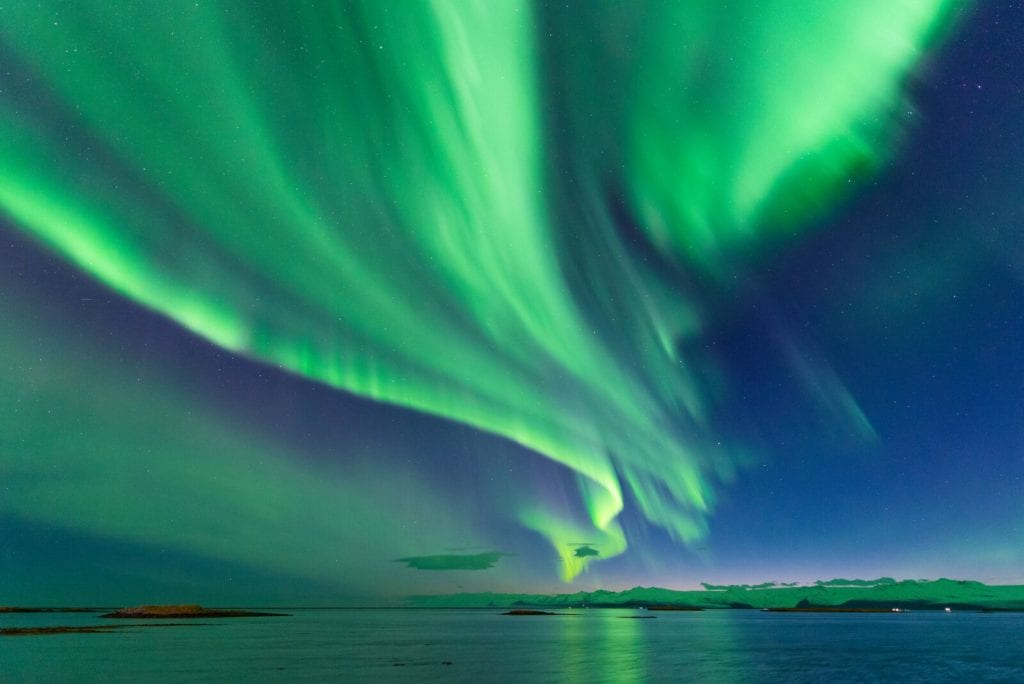
Aurora Borealis over Höfn. Photographer: Þorvarður Árnason.
The Northern Lights(Aurora Borealis) are a natural wonder that bring life to the dark winter nights of Iceland with fantastic forms and colors. Strong Aurora displays are magnificent to look at, and even the weaker displays can leave an impact on viewers. Visitors who experience the Northern Lights often want to capture the moment on film. Here we have a couple of tips for you, to capture the perfect Aurora Borealis photo.
Equipment
Your camera should preferably allow you to control all settings manually – this is where the essence of Aurora photography lies. The camera should be light-sensitive, i.e. be able to capture images at a high ISO setting without too much noise. Shoot in RAW format as then you can adjust the white balance of your Aurora images in post-production. A suitable lens is extremely important – this should be sharp and bright (aperture f2.8 or larger) and also fairly wide (20 mm or wider). Finally, a sturdy tripod is essential, as Aurora photography involves long exposure times and you must, therefore, keep the camera steady whilst the sensor is active. A remote shutter release is highly recommended to minimize the risk of camera shake – you can also use the self-timer on your camera.
Technique
There is no universally accepted way of making an Aurora photograph but here are some ‘ground rules’ based on personal experience. Set your lens to its widest aperture, to capture as much light as possible in the shortest time. Set its focus ring to infinity but make sure to check the focus on location and adjust as necessary, so that the stars are sharp. As you will be shooting a moving and dynamic target, a fast exposure time (3-5 seconds) is usually best, to increase your chances of capturing nuances in forms and colors that become blurred at slower exposures. This, however, involves a critical trade-off as you will need to use a high ISO setting which in turn leads to more noise. To find the perfect balance, you need to know your camera and how high you can set the ISO before the noise starts to seriously impair image quality. This should be your ‘default’ ISO setting and you can then vary the exposure time as the Aurora grows weaker or stronger. Weak Aurora displays will typically require exposure times of 10-20 seconds or longer. Make sure to double-check your focus at regular intervals, at least after each time that you move the tripod.

Aurora Borealis over Heinabergslón. Photographer: Þorvarður Árnason.
Location
An Aurora photograph not only involves capturing a wonderful display but must also take into account the terrestrial landscape underneath. The Vatnajökull Region with its striking and diverse glacial landscapes offers many sites where you can compose an expressive frame worthy of the Northern Lights. Usually, the Aurora will appear above or behind the glaciated mountain ranges in south Iceland and these thus provide an interesting foreground for the displays. Also keep an eye out for reflective surfaces, such as glacial lagoons or rivers – these can mirror the colors and shapes of the Aurora and thus ‘double’ their visual impact. To find the best location, you need to scout for them during the daylight hours and then plan to be on-site, ready to shoot, before the Aurora activity starts.
Safety
Aurora photography is a nocturnal winter activity. Leave your car in a proper parking spot and keep well away from main roads when you start to shoot. Other drivers cannot see you well in the night (sometimes not at all) and you also risk getting their headlights into the shot, ruining your photo. Please be considerate to other Aurora photographers you may encounter, e.g. by not shining your headlamp into their frames.
Summary
To sum up, after many years of Aurora photography, I would argue that there is no such thing as a ‘perfect’ Aurora photo. This does not, however, in any way diminish the unique experience and joy of undertaking such photographic adventures. Each encounter with the Northern Lights is a gift from Nature and one must not be blinded to this gift by the longing to capture it. Each new encounter is also an opportunity – and a challenge – to hone one´s skills and thus be ready to embrace the ultimate Aurora photo when everything on Heaven and Earth falls perfectly into place. So, until this happens, enjoy the celestial wonders to the fullest – and please stay safe.
– Þorvarður Árnason
Þorvarður Árnason is a local landscape photographer and filmmaker who has lived in the Vatnajökull Region for more than a decade. Examples of his Aurora photography can be found on the Facebook site Thorri Photo/Film. A timelapse film of the Northern Lights in the Vatnajökull Region can be viewed on the VisitVatnajokull website. For information about Aurora activity and cloud cover see auroraforecast.is and for driving conditions road.is.
For more Northern Lights photos and a Northern Lights video you can visit our photo gallery at: https://visitvatnajokull.is/gallery/





